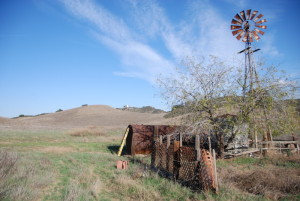 KB Home’s backdoor deal with the city of Simi Valley to build out Runkle Canyon may backfire with new radiation and chemical finds and evidence developer kept EPA from testing well contaminated with TCE
KB Home’s backdoor deal with the city of Simi Valley to build out Runkle Canyon may backfire with new radiation and chemical finds and evidence developer kept EPA from testing well contaminated with TCE
• Runkle Canyon planning meeting in Simi tonight – *UPDATED* BELOW
• EPA finds huge strontium-90 hit uphill and next to Runkle Canyon boundary
• DTSC signs off on KB Home’s shoddy testing of site for radiation
• Radiation Ranger finds evidence of possible nuclear and chemical dump in Runkle Canyon government and developer apparently missed
• New EPA radiation study finds alpha radiation in offsite well 2 miles from Rocketdyne with over 8 times alpha radiation’s Maximum Contaminant Level
The Simi Valley Planning Commission plans to rule tonight on whether to allow KB Home to extend its option to build in Runkle Canyon for another five years from 2014 to 2019.
KB Home’s Runkle Canyon LLC has been stymied in building 461 homes and condominiums in the 1,595-acre canyon since news broke in 2005 that neighboring Rocketdyne most likely contaminated the property with radioactive and chemical contamination including strontium-90 and trichloroethylene, or TCE.
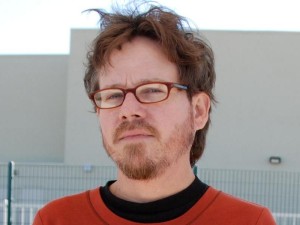
By 2006, a Simi Valley-based citizens group, the Radiation Rangers, formed and created a website StopRunkledye.com to organize resistance to the project. The group’s finding of toxic levels of heavy metals in Runkle Canyon Creek in 2007 also has delayed KB Home’s plans for a huge development hard on the border of the Santa Susana Field Laboratory, or SSFL.
SEE GALLERY of Runkle Canyon windmill well turned dumpsite
According to the Department of Energy, which operates Area IV on land leased from lab owner Boeing, a nuclear meltdown occurred at the site in 1959. Two partial meltdowns occurred at Area IV in 1964 and 1969. Radiological and chemical pollution at the lab, which is at the headwaters of the Los Angeles River, is so extensive that it has been the center of an environmental fight that stretches back to 1989.
So it would seem natural that the Westwood-based home building giant would want to quietly obtain the option of another half a decade to build on property adjacent SSFL. After all, the company has over a million dollars to hand over to the cash-strapped city which it dearly would love to have.
SEE GALLERY of May 17, 2012 SSFL Open House with EPA posters showing high strontium-90 adjacent Runkle Canyon and high alpha radiation in Brandeis-Bardin wells
Just one problem. The public. It wasn’t given notice for the meeting nor did it have a chance to legally comment on the city’s Runkle Canyon Final Environmental Impact Report Draft Addendum because, as its Department of Environmental Services document says, “Public review of an Addendum is not required by CEQA [the California Environmental Quality Act].”
However, if any Environmental Impact Report, or EIR, has significant new information, new EIR information must be developed and included according to state law.
“If new significant impacts or a substantial increase in the severity of significant impacts identified in the previous EIR would result,” the city report continues, “then preparation and circulation of a Subsequent or Supplemental EIR for additional public review is required.”
The public meeting subterfuge failed but just barely. Out walking his dog last week, Radiation Ranger “The Good Reverend John” saw a sign posted at the lonesome end of Sequoia Avenue declaring that a public meeting was taking place May 23.
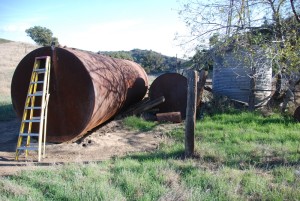
“With all the things wrong with Runkle Canyon and the intense fight the community has put up for six years trying to stop this thing, you’d would have thought the city would have the courtesy to at least tell us that they were going to have this meeting,” Rev. Southwick says. “Their excuse is that there’s nothing new to report but the city hasn’t a clue what’s going on in Runkle Canyon.”
“Signing off on this project with KB Home is like playing Runkle Roulette with a fully loaded revolver,” Rev. Southwick says. “The city and developers will pull the trigger but it’s the community that’ll get shot.”
EnviroReporter.com has uncovered evidence that KB Home has attempted to block the federal Environmental Protection Agency, or USEPA, from testing in a windmill well for cattle already known to be polluted by the carcinogen TCE in the highlands of Runkle Canyon.
This denial of access to Runkle Canyon comes even as astronomically high levels of Rocketdyne-related contamination has just been found miles away from the lab in a well at the Jewish educational retreat of Brandeis-Bardin Campus at American Jewish University in eastern Simi Valley. The facility is just downhill from the rocket and nuclear reactor complex at SSFL which is slowly being torn down and remediated.
Not only has the would-be developer of the picturesque canyon with broad meadows denied USEPA access to retest the Runkle Canyon well for any continued contamination, both it and the city of Simi Valley twice ignored Los Angeles Regional Water Quality Control directives in 2003 and 2004 to test Runkle Canyon Creek for pollution under the aegis of the Clean Water Act.
Runkle Canyon’s so-called “blue line” stream is part of the Calleguas watershed which is listed under the act as being impaired. Water from the canyon runs off to the Arroyo Simi where it percolates into the groundwater where it is re-pumped up, blended, and served to over 7,000 residents mostly in the eastern part of Simi Valley.
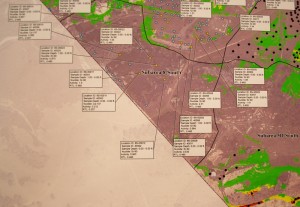
EnviroReporter.com has also learned that an extremely high detection of the radionuclide strontium-90 was recently detected by USEPA in bushes up gradient of Runkle Canyon just across the chain-link fence border of Area IV. That detection of Sr-90, without the usually corresponding cesium-137 signature, seems to confirm 1999 and 2000 developer tests showing high hits of the bone and blood cancer-inducing radionuclide’s presence, something KB Home has been trying to test away since 2007.
City and state government officials assert that these retests are more accurate than the plethora of analyses performed by several different labs for the developers. In addition, EnviroReporter.com uncovered evidence that not only were tests for strontium-90 in Runkle Canyon by the city and developers inaccurate and “suspect” according to standards of the Department of Energy, the actual methods used to acquire these suspect results were decades old and not the latest kind of radiation science used to detect radiation in soil.
Yet despite this evidence, the state EPA’s Department of Toxic Substances Control (DTSC) signed off on the safety of Runkle Canyon in December 2010 in the waning days of the Schwarzenegger administration. The decision came as a surprise to the community, who had been expecting a response to the hundreds of pages of public comment they had submitted regarding the contamination. Not only did DTSC ignore public comment by sending out an identical response to each commenter which didn’t answer their questions and concerns, the department relied on shaky science that led to its fateful decision. DTSC honchos trumpeted falsehoods about the environmental realities of Runkle Canyon to local media at the time giving residents the impression that there existed no toxic threats posed by the site’s conditions.
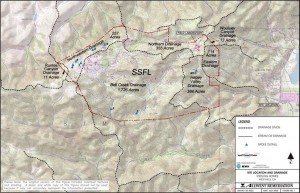
Shoddy city and developer testing along with new EPA radiation findings devastate the notion that Runkle Canyon is free of radioactive and chemical pollution caused by the adjacent Rocketdyne lab. Perhaps just as troubling is the continued pattern of the city of Simi Valley, Runkle Canyon’s developers and the state of California to dismiss the residents’ repeated, and backed up, assertions that Runkle Canyon is polluted by the neighboring property which has an 11-acre drainage into the canyon.
Residents like the Radiation Rangers had hoped that KB Home would abandon its plans to build on land so troubled by environmental concerns. But the end-around push to develop Runkle Canyon ignoring municipal and state law based on outdated and suspect science has made it clear that the community is on its own. It will have to attempt to protect itself from, among other consequences of construction, over 112 tons of strontium-90 impacted dust being launched into the air that will land on both the Simi and San Fernando valleys.
The Radiation Rangers and longtime Rocketdyne cleanup activists have drawn a line in the sand. That line may be breached tonight if the Simi Valley Planning Commission signs off on one of the most controversial development projects Southern California has ever experienced.
The Runkle Canyon windmill well is several hundred yards from the property line of Area IV of the Santa Susana Field Laboratory in the hills between the Simi and San Fernando valleys. At over 2,000 feet elevation, the well has been used to water cattle that have grazed on the land intermittently for decades.
The slope on which the Runkle windmill site sits drains into the Upper Las Virgenes Open Space Preserve, or Ahmanson Ranch. The ranch also was a target for development over a decade ago when then-existent bank Washington Mutual had endeavored to build thousands of luxury homes also on land adjacent Area IV and Rocketdyne’s so-called southern buffer zone.
That project when belly-up when, in 2002 for the LA Weekly newspaper, this reporter questioned the makeup of the 660,000 gallons of groundwater that “WaMu” planned to use daily to water parks, common areas and the proposed golf course. One water test came back positive for perchlorate, a rocket fuel oxidizer that is toxic and targets the thyroid making it especially dangerous for children and pregnant women.
That was the beginning of the end for the Ahmanson Ranch project. WaMu donated the land to the state of California in October 2003 for $150 million, a fraction of what the $2 billion development was potentially worth. The acclaim for this environmental victory stands in stark contrast to the verbal bloodbath unleashed by the fighting over Runkle Canyon in the last seven years.
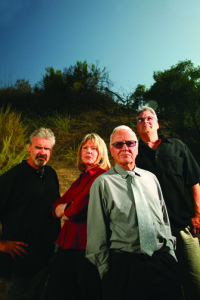
Today, downhill from Runkle’s windmill well, Ahmanson Ranch’s stream water has the same chemical sheen that Runkle Canyon Creek water does, creek water that tested high for arsenic, nickel and vanadium by the Radiation Rangers in 2007. The city of Simi Valley retested the creek two months later and found even higher results for toxic heavy metals in the ephemeral stream yet, oddly, proclaimed in the local press that their results came back clean.
Next to the well are dozens of 55-gallon drums that appear to have contained solvents or some other kind of toxic material that have been illegally dumped on the site and left to corrode. The contents appear to have burned the outside skins of the barrels and the grass around them.
SEE GALLERY of Runkle Canyon windmill well turned dumpsite
Most striking, however, are two giant metal tanks, one of which used to hold 8,000 gallons and still has its metal label intact: UNDERGROUND TANK FOR FLAMMABLE LIQUIDS. The massive tank is tipped towards the windmill well with tubes running from its top into the substrata clearly to pour the contents into the well.
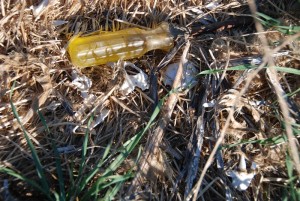 “As I walked up to the tanks I felt like I was crushing snails in the grass and as I looked closer it was literally hundreds of animal bones from the unlucky critters who drank the water from the old trough,” says “Wild Bill” Bowling, a Radiation Ranger and a leading Rocketdyne cleanup activist. Bowling founded the Aerospace Contamination Museum of Education and has been fighting for cleanup of SSFL for nearly a decade.
“As I walked up to the tanks I felt like I was crushing snails in the grass and as I looked closer it was literally hundreds of animal bones from the unlucky critters who drank the water from the old trough,” says “Wild Bill” Bowling, a Radiation Ranger and a leading Rocketdyne cleanup activist. Bowling founded the Aerospace Contamination Museum of Education and has been fighting for cleanup of SSFL for nearly a decade.
“It was macabre walking on all these bones crunching under my boots,” says Bowling. “But it wasn’t so creepy that I didn’t see what whoever transported these giant tanks also drained them at the well. That someone, most likely from the lab since there is no other plausible explanation, would dump these massive tanks here defies belief but there they are corroding away on land that is supposed to be used for hikers and bikers as open space.”
EnviroReporter.com has verified Bowling’s photographs of Runkle Canyon’s windmill well to be authentic. Galleries of the well in 2009 and then again in 2011 show that KB Home has done nothing to remove these dangerous structures from its property which is in violation of Simi Valley dumping ordnances.
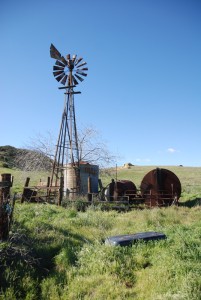
“Something seemed wrong the first time I saw them. As I looked at the tanks closer I noticed a hose system attached in a very crude way and realized that these were designed to drain into the windmill well, injection style,” Bowling tells EnviroReporter.com. “They even went so far as to put 2 x 4’s under the tank so that a couple of workers could tilt the tank to help with the gravitational flow into in the earth via this old windmill that looks out of the Old West.”
The tanks and corroded barrels look vintage Rocketdyne, however. With the lab as a next door neighbor, the most likely suspect for the dumping of the Cold War-era debris and contaminants on the well that watered countless cattle is SSFL.
Indeed, EnviroReporter.com and Bowling’s site RocketdyneArchives.com both have photos of tanks at Rocketdyne that are nearly identical with the ones sitting haphazard on rotting planks at Runkle Canyon’s windmill well. This bottom center photo looks like the big tank and this top middle photo looks like the smaller of the oversized tanks. Image 9 and Image 17 look like they could be either tank and the fourth from bottom photo called “Removal of Radioactive Waste UST (Underground Storage Tank) of Building 4020” looks like the smaller Runkle windmill tank.
Barrels found at the windmill well are identical to the ones in the photo in the third row, far right. Thousands of barrels of radioactive and chemically-contaminated goo were chucked into Area IV’s sodium fuel pit where in a small sea of radioactive goo, workers would draw straws to see who would be able to shoot a rifle at the barrels which would explode when shot releasing their extremely toxic radioactive contents into the air.

Before Bowling learned the dirty secrets of Runkle Canyon’s windmill well firsthand, he knew of the place as “Offsite Well #21” or OS-21 from reports on offsite contamination generated by Boeing subcontractors. Arcadia, California-based MWH environmental engineers tested OS-21 and found it to be positive for TCE in a December 2007 report prepared for Boeing (10.57 MB; Figure 3.1, Page 184/199).
It was an odd place to find the carcinogenic rocket engine and hardware solvent since most of the intense use of the sickly-sweet smelling goo took place further east and north at SSFL at rocket test stands in Areas I, II and III. A map of Area IV TCE (4th row down, middle) does reveal, however, contamination in that part of the lab which housed experimental nuclear reactors, a Radioactive Material Handling Facility and a Hot Lab where spent fuel rods from nuclear reactors around the country were cut apart.
Before becoming a Radiation Ranger, Bowling had warned the Simi Valley City Council about the well and, for once, city officials seemed to take residents seriously about pollution from Rocketdyne oozing off the site onto and under Runkle Canyon.
“This windmill well could potentially draw the contamination offsite,” Bowling told the council at a special Runkle Canyon public meeting in Simi Valley City Council chambers November 17, 2008.
Bowling described how Boeing and land lessor NASA had turned off their groundwater remediation systems to clean the groundwater of TCE back in 2000. That “air-stripping” carbonated system cleaned about 10 gallons of the volatile organic compound from groundwater each year.
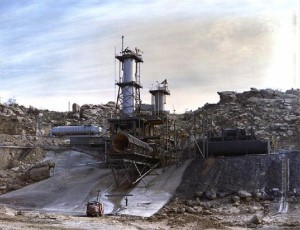
Over 30,000 rocket engine tests took place at SSFL during the go-go years of the Cold War leaving at least 530,000 gallons of the goo in the groundwater. The disconnected system would have taken 53,000 years to complete its job.
For once, the city council seemed to listen and take the stark reality of having one of the most polluted places in Southern California bordering the city.
“Mr. Mayor, maybe we could ask staff, I don’t know, where the windmill is,” said Councilmember Glen Becerra after Bowling’s comment. “I’m sure they could let us know. Why couldn’t we ask staff to contact KB and ask them to turn it off? You could disconnect the pump from the windmill itself so it’s not pumping any water unless they are using it up there and I highly doubt they are using it up there so…”
“We could do it,” now-former Mayor Paul Miller responded. “We’ll have staff check it out.”
Clearly no city staff checked it out or they would have noticed, among other things, that the giant tanks and dozens of decaying barrels in and of themselves violate city dumping laws and would certainly pose a hazard to the people using the open space for recreational activities.
That wasn’t the case when USEPA was granted access to an offsite well on the Brandeis-Bardin property. There, at OS-10, the agency detected beta radiation in the well water at nearly three times its MCL for drinking water. Total adjusted gross alpha radiation activity was 8.61 times its MCL which is even more troubling: alpha radiation is up to 60 to 1,000 times more dangerous than beta or gamma radiation because of the harm it causes upon ingestion or inhalation.
SEE GALLERY of May 17, 2012 SSFL Open House with EPA posters showing high strontium-90 adjacent Runkle Canyon and high alpha radiation in Brandeis-Bardin wells
These astronomically high radiation readings on Brandeis-Bardin come from a well over two miles from Area IV. Runkle Canyon’s windmill well is just a half mile from the polluted lab. Yet even with the importance of testing that well, KB Home’s lawyers have given USEPA the “runaround” according to Rev. Southwick.
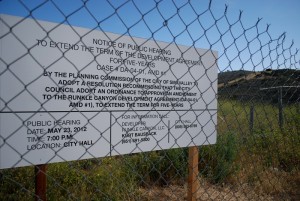
“The USEPA folks at the May 17 SSFL Open House told me KB Home said there was no reason, or evidence, that would make them allow access,” says Rev. Southwick. “They told the government to take a hike but certainly not on Runkle Canyon. It’s clear they have something in and around the well to hide and thanks to Wild Bill, now we know what – a possible nuclear and chemical dump by and in the windmill which sends its poisons downhill into Ahmanson Ranch to inflict unknowing visitors to that park who are unwittingly exposed to Rocketdyne toxins in the stream water.”
Ahmanson Ranch’s streams form the headwaters of Las Virgenes Creek, also protected by the Clean Water Act. This reporter has personally seen and photographed the gooey waters of Ahmanson Ranch careful to avoid skin contact. Other visitors to the park that day in 2005 didn’t show the same caution even allowing children to frolic in the cooling waters on a hot summer day. They didn’t know any better as no signage explains what the gooey waters contain or if they are contaminated by upstream pollution.
Simi Valley planning staff also failed to enforce rules requiring Runkle Canyon’s developer to adhere to Section 303 (d) of the Clean Water Act.
In a July 22, 2003 letter to the city’s John F. Fields acquired by EnviroReporter.com, the California Regional Water Quality Control Board, Los Angeles Region (LARWQCB) states that “The project site lies in the Calleguas watershed that was listed as being impaired.”
“Constituents causing impairment in the Calleguas watershed include pesticides, metals, nitrogen, sedimentation, algae, salts and coliform,” LARWQCB associate geologist Elizabeth Erickson wrote. “Our review of your documentation shows that it does not include information on how this project will change the loading of these pollutants into the watershed. Please provide the following additional information for both the construction and operational phases of the project.”
The city of Simi Valley failed to respond. LARWQCB sent another letter to the city March 16, 2004 this time addressed to Adam Keller. Again, the city did not bother to respond.
Can a municipality simply ignore a state agency’s request for a construction project to follow the Clean Water Act? Apparently so.
“I can tell you I think we probably never received any response,” said L.B. Nye in a voicemail to EnviroReporter.com January 19, 2011. “We don’t often write letters in response to CEQA documents because we don’t have the statute to do so. We do sometimes when it’s important enough. And probably we didn’t receive a response to this letter. They probably, if they responded, incorporated the concerns in their next draft of the EIR.”
Nye correctly predicted that the developer, Runkle Canyon LLC, which was sold by original developer Peter Kiesecker GreenPark Runkle to KB Home in 2006, would include an explanation in the EIR explaining why it hadn’t tested Runkle Creek for these harmful constituents.
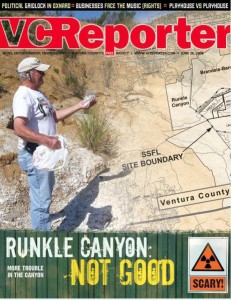
“The Runkle Canyon project will not result in significant water quality impacts; including any substantial increase in loading of the pollutant constituents of concern for the Calleguas Creek Watershed identified in this letter,” the EIR contended with no evidence to back it up. “Lastly, because the project will contribute a minimal impact on surface water quality and because of the lack of reliable information on which to base any quantified load estimates, no estimates are provided.”
In other words, because Runkle Canyon LLC didn’t bother to conduct any creek water tests, it wouldn’t provide any of the information that LARWQCB demanded twice.
Perhaps as disingenuous is EIR’s notion that rain water in Runkle Canyon has little opportunity to soak into the soil therefore the runoff would be the same as future runoff in the canyon once it’s filled with impermeable surfaces like asphalt and concrete.
“[T]he proposed development is located in the moderately-sloping hillside regions of the site that under existing conditions promotes storm runoff to travel down the existing hillsides, limiting opportunites for percolation,” the EIR claims with no proof. “Project development will continue to travel down the existing hillsides, limiting opportunities for percolation.”
Even a cursory look at Runkle Canyon photographs clearly shows that the verdant canyon most certainly does soak up water. Combined with enormous catch basins and other water features, KB Home will certainly change water runoff both in quantity and quality despite protestations that Runkle Canyon’s grasslands are essentially the same as concrete and asphalt sidewalks, driveways and roadways.
 The Radiation Rangers think they know why KB Home has continued to resist testing this water, which is used by cattle, wild animals including cougars and the pet dogs people have walked in the canyon over the years; it’s polluted.
The Radiation Rangers think they know why KB Home has continued to resist testing this water, which is used by cattle, wild animals including cougars and the pet dogs people have walked in the canyon over the years; it’s polluted.
The citizens group went and did its own expensive testing of Runkle Canyon Creek water in May 2007 after a chemical sheen was seen in the mucky goo. The $3,000 worth of results were shocking.
Runkle Canyon’s surface water readings for poisonous arsenic were 15 times the MCL for drinking water, over 21,000 times the EPA’s “Preliminary Remediation Goal” and 37,500 times the agency’s “Public Health Goal” for potable water.
The mud sample was laced with arsenic as well, coming in at over 548 times the EPA’s PRG for the contaminant in soil. That amount of the toxin is also 213 percent of DTSC’s arsenic “field action level,” where further investigation is warranted.
The toxic metals nickel and vanadium were also detected in the water at worrisome levels by the Pat-Chem lab employed by the Rangers, in the case of the later, tripping a government “notification level” designed to keep pollutants out of the drinking water supply.
Nickel was over 12 times the EPA’s PHG in water and vanadium came in at 1.8 times the notification level which is a threshold at which the most local government entity should be informed. That entity would seemed to have been the city of Simi Valley since it annexed Runkle Canyon in September 2004 and incorporated it into the municipality in 2006.
The city took no action even when confronted with the Radiation Rangers and angry citizens in public meetings including city council conferences. But Simi Valley took action two months later when it hired the same Pat-Chem team to retest Runkle Canyon Creek for heavy metals. Mayor Miller and a host of city and county officials, along with a KB Home representative, asked Rev. Southwick to guide the group to the same spots the Rangers had tested.
The city’s tests came back with an even higher amount of arsenic in the water than the Rangers did. The reading for arsenic, which causes bladder and lung cancers as well as diabetes, developmental problems, gastrointestinal illness and heart disease, was 25 percent higher. That translates to 26,478 times tap water’s PRG and 47,000 times California’s PHG for the toxin in drinking water.
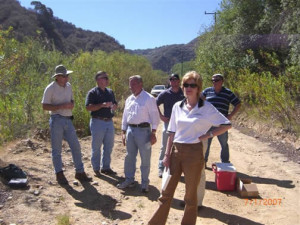
Another regulated heavy metal found by the Rangers in Runkle Canyon water, barium, was detected at levels 233 percent higher than the citizens’ sampling. Nickel came in 33 percent higher and vanadium 55 percent more elevated than the earlier tests.
Runkle Canyon Creek water sloshes periodically into the Arroyo Simi where it percolates into the aquifer and is blended with imported water to drink. The water is a source for Simi Valley drinking supplies.
DTSC differs on what to most folks would seem an obvious fact. Former Runkle Canyon and Rocketdyne cleanup projects head for the department, Norman E. Riley, told the Simi Valley City Council in a special session that DTSC considers “the tap” as the water source, meaning water after it has already been blended and processed for safe consumption. That is not the definition of a water source according to numerous state and federal agencies.
Riley was sacked not long after that remark yet his successor, Rick Brausch, and DTSC geologist John Naginis, seemed unclear on even the nature of water sources in Southern California according to remarks he made to the Radiation Rangers and other concerned citizens at a meeting to discuss DTSC’s “No Further Action” (NFA) needed for Runkle Canyon cleanup. The meeting was held at DTSC’s Chatsworth offices January 31, 2011 to explain the department’s decision.
“We do not consider surface water in Runkle Canyon to be drinking water,” Naginis said to the astonished gasps of the assembly of citizens. “Because it’s not drinking water, the higher standards do not apply.”
“I don’t know at this point whether or not that stream feeds into a surface water body that is drawn from by a water company,” Brausch elaborated. “Typically in this area, groundwater is the primary source of drinking water and those are usually extracted from great depths. Typically surface water sources here in Southern California are not usually used.”
As seen in the video to the left, “The Good Reverend” John Southwick expressed dismay at DTSC’s decision January 2011 to issue a No Further Action decision on Runkle Canyon after claiming in the press falsely that KB Home laboratory Dade Moeller was more precise than earlier developer labs that found astronomically high amounts of strontium-90 in the canyon next to Rocketdyne. Actually, Dade Moeller’s technique, from the 1970s, resulted in “suspect” low radiation readings.
Typically, government officials in charge of a cleanup project know what they’re talking about. In this case, Brausch and Naginis had no clear idea that indeed Runkle Canyon Creek fed into the Arroyo Simi and was a blue line stream protected by the Clean Water Act.
Brausch and DTSC brushed aside high strontium-90 readings detected by the developer’s laboratories in 1999 and 2000 where the deadly radionuclide was found on Runkle property at hundreds of times background as reported in 2005 in the Ventura County Reporter cover story “Which Way the Wind Blows.”
Indeed, when the NFA was announced, DTSC officials crowed about use of more modern technology to determine the amount of strontium 90 in Runkle Canyon.
“DTSC does not know for certain why there is a difference between the data collected in 1999 and the investigations performed since 2005,” DTSC public information officer Jeanne Garcia told the Ventura County Star in a December 29, 2010 article. “Doing the strontium testing is a complicated procedure, it requires skill on the part of the chemist, and the procedures have been improving over time.”
“We did not find similar results to ’99,” Brausch told the Simi Valley Acorn as reported December 17, 2010. “In fact, most of the data was much more in line with the subsequent developer-generated data. Our data was also very closely in line with the split-sample data from the developer.”

“It’s always good news when we verify there isn’t environmental contamination and exposure to contaminants,” he said.
Indeed, it is always good news to be able to verify that but Brausch, DTSC and KB Home’s lab for the sampling, Richland, Washington-based Dade Moeller Associates did nothing of the sort.
Dade Moeller used testing techniques from the 1970s, not the latest strontium-90 testing techniques developed in 1990 by Eichrom, testing techniques currently used by USEPA in its $41 million radiological assessment of Area IV as part of an SSFL cleanup that has cost several hundred million to date.
EnviroReporter.com has obtained documentation that shows just how science-challenged Dade Moeller’s tests were. Yet these tests have been eagerly embraced by DTSC and the city of Simi Valley as proof that Runkle Canyon’s chain-link fence has keep Rocketdyne goo off the property. The battle over which science is accurate will help determine the futures of both the Simi and western San Fernando valleys.
Dade Moeller used EPA Method 905.0 developed in the 1970s to retest for radionuclides at Runkle Canyon, not the Eichrom resin method introduced in 1990. The original developer tests beginning in 1999 that yielded the high strontium 90 results used the newest and most reliable method called Eichrom.
Why Dade Moeller switched to the older cumbersome method instead of attempting to duplicate the original reports’ results is not known. What is known is the old method is troublesome and didn’t match the techniques used in 1999 by the developer’s lab, Houston, Texas-based Foster Wheeler.
“The Eichrom procedure is just a newer procedure and solves some of the problems inherent in EPA 905.0,” USEPA senior science advisor Gregg Dempsey told EnviroReporter.com January 11, 2011 by email. “EPA 905.0 is quite tedious and therefore somewhat unpopular. You can’t “cookbook” your way through either procedure, you have to know what you’re doing.”
Dade Moeller apparently had problems with the old method according to Dan Hirsch of the nuclear watchdog group Committee to Bridge the Gap. News of the 1959 meltdown came through the efforts of students in a class Hirsch taught at UCLA in 1979.

“The tests that were made by Foster Wheeler used the most modern technique, the technique that EPA has determined is the most reliable and is using [at SSFL],” Hirsch said at the January 31, 2011 DTSC Runkle Canyon NFA meeting via telephone. “They have chosen not to use the old 30 year procedure because it has a tendency to produce errors when the chemist is not really really expert. So the old tests actually used the modern technique. [Dade Moeller’s] tests used the old technique that EPA has chosen not to use because the potential for being wrong. Their advice about what you needed to do to make sure the chemist knew what he or she was doing, in my understanding, was not followed.”
Not only were USEPA’s advice to DTSC and Dade Moeller not followed, the developer’s lab had a dismal success rate in correctly determining the amount of strontium 90 in Runkle Canyon soils. Out of 36 samples, 15 of these samples had a recovery rate of less than 40 percent which is the lowest percentage one can still have reasonable confidence in for accuracy. Five of the samples had a recovery rate of less than 30%.
“If you look at Method 905.0, there are a total of at least six precipitations using multiple acids and bases prior to the final precipitation for strontium 90, and if you’re looking for strontium 90 itself, then you have additional precipitations afterwards for a total of at least eleven precipitations, possibly more depending on how the sample is purifying along the way,” Terry O’Brien of Eichrom told EnviroReporter.com January 13, 2011. “Whereas with the Eichrom technology, you do one additional precipitation depending on your sample size. Our typical users of our products want a very high degree of sensitivity, recovery and precision and accuracy.”
“When you’re doing a total of eleven precipitations, the likelihood of things to go bad is very high,” O’Brien continued. “You have to do quantitative transfers from eleven different precipitations, you’re saving precipitate. If you screw up, you’re done. You’ve just lost the majority of what you’re looking for. You can go very, very quickly from having a great recovery to a horrible recovery.”
O’Brien said that typical reporting requirements under the Department of Energy say that data should be termed “suspect” if the recovery rate goes below 40 percent.
 Nevertheless, DTSC decided to make bold statements based on bad science when deciding which set of results for Runkle Canyon was more accurate.
Nevertheless, DTSC decided to make bold statements based on bad science when deciding which set of results for Runkle Canyon was more accurate.
“DTSC cannot verify the Foster Wheeler or Harding ESE results,” the department wrote in its December 2010 Runkle Canyon report. “DTSC suspects but cannot confirm that the Foster Wheeler and Harding ESE results may have been an artifact of the sampling methodology, laboratory analysis or lack of stringent quality assurance and quality control measures. In any case, DTSC was not able to verify the results.”
To put this disingenuous fib in context; Brausch is attempting to cast doubt on the original developer’s own reports from 1999 and 2000, reports that used the latest strontium-90 lab method, the same method that USEPA is using to test for Sr-90 in its sampling on “The Hill,” Rocketdyne’s longtime moniker.
Testing away the high testing results didn’t begin with Brausch, however, it began with shrewd real estate investor Peter Kiesecker whose repeated radiation test of the Runkle Canyon reduced the amount of strontium 90 significantly as we showed in our first expose on the place, “Neighborhood Threat,” in 2005.
Kiesecker sold Runkle Canyon to KB Home in 2006 for reportedly $38 million, quite a sum considering the scandal that had broken loose the year before. But KB Home was used to taking risks. Its CEO at the time was Bruce Karatz who ended up being convicted of a felony for two counts of making a false statement over a stock price manipulation scheme. Never admitting wrongdoing, Karatz paid back KB Home $8.5 million and paying $480,000 to the Securities and Exchange Commission to settle a civil case.
In Runkle Canyon’s case, not only was Brausch wrong about the 2010 Eberline and Dade Moeller tests for KB Home antiquated and notoriously inaccurate in comparison to the 1999 and 2000 radiation testing, the actual lab data was a fraction what it was when the initial rounds of Runkle Canyon strontium 90 testing found radiation hundreds of times above normal. The 2010 reports added up to 148 pages while the 1999 Foster Wheeler report and the 2000 Harding ESE report, both using the newer and much more accurate Eichrom strontium 90 detection method, combined for a total of 2,724 pages.
“Brausch was just blowing smoke trying to discredit the reports which is what he has been doing since he showed up to slick over KB’s problems,” says Rev. Southwick. “He correctly calculates that most people will assume he’s telling the truth about such an important issue because he works for DTSC. Rick’ll probably claim we put those flammable fuel tanks up at the windmill well just like Norm Riley tried to intimate we planted the rocks loaded with chromium in Runkle Canyon.”
Even though DTSC wasn’t able to “verify” the results of the 1999 and 2000 reports, that didn’t prevent the department from declaring that the strontium 90 problem in Runkle Canyon was no more based on the “suspect” Dade Moeller reports.
That is until now.
USEPA, in its latest round of sampling in Area IV, found strontium 90 up-gradient from Runkle Canyon by the fence borderline clocking in at over 145 times normal background for the isotope at one to five feet below surface.
As a measure of how serious this is, the California Highway Patrol considers any radiological detection above three times background to be a hazardous materials situation which triggers haz-mat protocols for the law enforcement agency.
SEE GALLERY of Runkle Canyon windmill well turned dumpsite
Like the strontium 90 found in Runkle Canyon at such high levels in 1999 and 2000, this detection did not come with a similar amount of accompanying cesium 137. That disproves one of the main arguments of DTSC that the earlier Runkle Canyon tests were inaccurate: the Sr-90 did not closely match Cs-137 in concentration.
Now that high Sr-90 at Rocketdyne has been detected without the corresponding Cs-137, it invalidates DTSC’s unsound science based, it seems, on wishful thinking.
Another curious aspect to the huge strontium-90 hit on SSFL property next to the Runkle fence: it was found up a hill overlooking and draining into Runkle Canyon where no known radiological work was done. The rise is native chaparral but as Dempsey noted recently, old tire tracks led to the sampling spot suggesting that the deadly radionuclide was deliberately dump on a hillside that drains into supposedly squeaky clean Runkle Canyon.
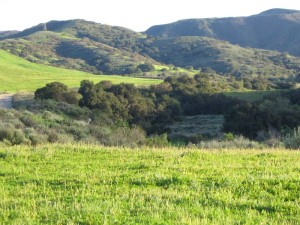
“The key matter is the finding of separated strontium-90 by EPA at SSFL in areas abutting Runkle Ranch,” Hirsch says using the historic name for the area. “DTSC had said that they discounted the findings of strontium-90 at Runkle in part because it appeared without cesium-137, which they said was unlikely, and that they had no evidence of strontium-90 contamination at SSFL nearby, but could revisit the matter if strontium were found at SSFL near Runkle. Now it has been found. A supplemental EIR should be performed, and finally, credible, careful independent measurements made.”
USEPA’s Dempsey seems to agree according to a March 9, 2012 email of his published on a blog recently.
“In my experience, I’ve seen people look at artificial barriers like roads, fences, property lines, rivers, etc., and decide in their minds that radiation can’t cross that barrier, which is kind of silly when you look at it later,” Dempsey wrote. “In the bigger picture it’s just more important that we identify it so we can get it cleaned up. That’s really the most important part.”
****
TONIGHT’S MEETING:
Simi Valley Planning Commission
City Council Chambers
2929 Tapo Canyon Road
Simi Valley, CA 93063
Call to Order: 7:00 pm
* UPDATE – After a heated Simi Valley Planning Commission meeting in which a KB Home representative claimed that no Runkle Canyon windmill flammable liquids tanks are dumped on the property and that it hadn’t denied access to the EPA trying to re-sample the well which has tested positive for TCE, the commission agreed they needed to revisit the issue in greater detail before coming to a decision. The meeting was adjourned until June 6, 2012.
25 Years of Award-Winning SSFL/Rocketdyne Reporting
1998 – 2023












Wow, and to think I used to ride bikes as a kid down Peppertree Lane to the Brandeis Institute. How many more citizens have to get sick or die before something is done about this! Thanks so much!
Once again the truth is out there—-
If only if KB home will just look and find it.
Thanks Michael for staying with us during this fight,even though sometimes it seems it is like banging your head against the wall.
Bravo Mr. Collins.
Norm ‘Shenanigans’ Riley also disgusts me. His ‘science’ has been repeatedly debunked as nonsense. I hereby question his motive and design.
Good on you Michael, Rev. John, Terry, Frank, Patty, and Bill for all your investigative efforts.
This toxic abyss of unimagined depths amazes — deliberately dumped liquid wastes into wells that feed directly into the water table below the mountain. Radioactive contamination has been found miles away in places such as Chatsworth Reservoir. The long term fate of the huge aquifer is in jeopardy.
‘Waste Holdings’ were shipped in from offsite. How many millions of Curies of transuranic waste? Contaminated soil poses a threat to the community’s water table.
Responsibility of the felon-polluter is to either prove that dangerous concentrations of waste never reach the groundwater (and water table and aquifer) or to act quickly to sponge up percolating poisons. Since the former fails the sensible science test, the quickness of clean up, then, is at issue.
Being ‘quick’ is not the same as how fast the polluter desires to cut and run. Beware the repeat of shenanigans in the form of paid corporate experts trying to bamboozle the public at meetings. Advice: do not buy into their incomplete science, question everything, and investigate independently to verify the tangled web big money tries to weave.
The frightening thing is nothing has been cleaned up. There is paper pushing, but nothing is being accomplished. I am disgusted by how little actual cleanup action is underway here.
Suggestion: prepare a jam from Runkle Ranch prickly pear cactus fruit or sage or other native edibles found at Runkle (be imaginative — seek recipes online or consult with the Chumash museum in North Ranch / T.O.). Make a few jars of Runkle jam and mail them to DOE Secretary Chu, Governor Brown, Mayor of Simi, and 9th Circuit Appeals Justices with the following label on the jar:
“This _________(insert type of preserves made) jam is a token of the future hazard of unidentified, uncontained, and unmanaged radioactivity at Runkle Ranch. Courtesy of the Radiation Rangers.”
90Sr, 90Y, 89Sr, are in Runkle for at least one reason, that being because Radioisotope Thermoelectric Generators (RTGs) were created as part of Systems for Nuclear Auxiliary Power (SNAP), “a joint project of the U.S. Atomic Energy Commission and NASA”. There were several SNAP mishaps at Rocketdyne.
“RTGs are sometimes called ‘atomic batteries.’ They can be built with any of the following radioisotopes: Strontium-90, Curium-242, Plutonium-238 and Polonium-210”
From the following chapter (please read this one and the whole e-book):
http://www.nuclearcrimes.org/7-1.php
Getting out some hot Runkle jam would spark heightened interest in clean up.
May 28, 2012: Bluefin tuna caught off of San Diego in August 2011 tests positive for cesium 134 and cesium 137 radiation, isotopic identifiers with the Fukushima Daiichi triple meltdowns polluting the Pacific. Rense and Collins discuss the implications as the amount of highly-poisonous radioactive water from Fukushima pours at least 1,000 tons of contamination into the ocean daily leading to bioaccumulation now seen in some of the top of the food chain marine creatures.
Thank you Michael Collins for your excellent reporting. Keep it up. We need to know the truth about the contamination from the SSFL site.
Hard to say what’s scarier – the contamination or the abuse of public process. Go go go, M.C.!
Thanks again, Michael, for staying on the Runkle story, and uncovering all of the incompetence, denying, lying, greed, and disregard of potential harm to unknowing humans, by would be home builders, labs, real estate brokers,city officials and Government regulators who appear to have been looking the other way, in honor of the mighty dollar.
All of this is really not only just a tale of greedy malfeasance and uncaring incompetence, it is really a story of a FELONY CRIME…..happening in very slow motion, before our very eyes.
Again…we are grateful for the ongoing persistence and efforts of the Rangers, which includes you and Bill, and we are certainly glad that you have been able, so far, to keep any houses from being built and occupied on Runkle Canyon.
Public officials selling out their own meal ticket. Let’s see how long they remain public officials. They could ask Norm Riley how that worked out for him. There is no public trust left to betray, and for good reason.
Man, this is the nightmare that keeps on giving–some vested interest is going to decided that the only way to stop the dirt from being revealed is to bury Collins under a pile of strontium-90-laced dirt.
Wow what a dynamite story. We would never know the whole story without Michael Collins. The coverup gets deeper and the news gets worse every day. I can’t imagine anything worse than having contamination in the drinking water, even if it is for the cows.
You are doing a great job, reporting truths that needs to get out to the uninformed. I’ve tried several times to C&P, or capture to print, in order to pass the information to others who are uninformed. Unfortunately, your website is NOT PRINTER FRIENDLY. Is there a reason for this? As long as your website is given credit, and links are passed on with the printed material, you would get more traffic, and certainly you would be achieving your purpose (which I’m presuming is to spread the WORD).
Major workarounds in order to print your articles; Perhaps you might want to allow for CUT and PASTE, or WORD friendly, or even PDF?
Keep up the good work. I’d like to spread it around….
ciao for now,
richRAD
Thank you Michael Collins for staying on this issue even when all hope was lost with the DTSC determination of a No Further Action. The truth will be much more stranger than fiction as we find out how they bend the truth to please the money provider. Not one person representing KB Home at the Planning Commission meeting would confirm or deny that they turned down EPA’s request to sample the “Windmill Well”…Onward to June 6th,
William Preston Bowling
Founder ACME (Aerospace Contamination Museum of Education)